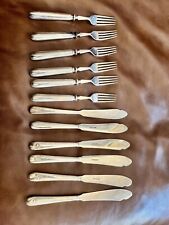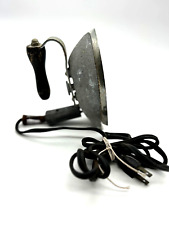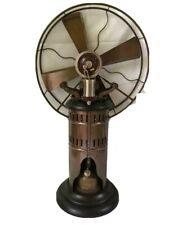|

On eBay Now...
Antique Steam Locomotive Stevengraph Pure Silk Woven Picture \"The Present Time\" For Sale

When you click on links to various merchants on this site and make a purchase, this can result in this site earning a commission. Affiliate programs and affiliations include, but are not limited to, the eBay Partner Network.

Antique Steam Locomotive Stevengraph Pure Silk Woven Picture \"The Present Time\":
$175.00
Frame is 8.75\" x 6\", sight is 2\" x 6\" original frame. Stevengraph is in great<br>condition, original frame shows some wear.<br><br><br>The Fascinating World of Stevengraphs.<br><br>By Bill Poese.<br><br>THE FASCINATING silk pictures that we know today as Stevengraphs actually had<br>their origin in a depression in England\'s far flung textile industry, and<br>Richard Cobden, a 19th century English economist and statesman, may claim some<br>of the credit.<br><br>In 1860, the so-called Cobden Treaty, a free-trade treaty negotiated by Cobden<br>and removing England\'s protective tariff on silks, brocades and ribbons, among<br>other things, took effect. Its impact upon Coventry, where English ribbon<br>weaving had been concentrated for 150 years, was devastating. Forty five per<br>cent of Coventry\'s population earned their livelihood from ribbon weaving. Looms<br>were destroyed, and during a two-year period 9,000 persons emigrated to foreign<br>countries in search of employment.<br><br>But there was one man who was resourceful enough to overcome the blow<br>sufficiently to provide for his own family, the weavers in his employ, and, in a<br>small way, to bolster the economy of Coventry. This man was Thomas Stevens, born<br>in 1828 in the outlying district of Foleshill.<br><br>As a boy, Thomas Stevens had learned the ribbon weaver\'s trade at the firm of<br>Pears and Franklin in Upper Well Street, Coventry, and in 1854 he set up his own<br>business in Queen Street. He had learned all the aspects of his trade well and<br>the jacquard loom was of particular interest to him.<br><br>This loom was a French invention of about 1790 of Joseph Jacquard that had been<br>introduced into England in 1820, and its excellence was recognized quickly, so<br>that by 1838 as many as 2,200 jacquard looms were thumping in Coventry. The<br>principle of the jacquard loom is based upon the fact that mechanically-operated<br>devices controlled loops and pulleys to weave patterns in textiles.<br><br>Thomas Stevens improved, adapted, and refined the loom by a series of inventions<br>so that he could produce silk pieces that have exquisite detail with what seems<br>to be a three-dimensional effect. He produced pictures, musical notes, lettering<br>and portraits of amazing beauty. The first step in producing Stevengraph works<br>was an artist\'s drawing on squared paper. These designs were originals, copies<br>of portraits, copies of prints, and often of texts in the manner of illuminated<br>manuscripts. The Victorian love of covering the entire surface of the piece is<br>often in evidence in these pieces. The squared paper pictures look like designs<br>for cross-stitch embroidery work.<br><br>Large cards were made that carried out the artist\'s picture and a separate card<br>was made and per- forated for each color in every single woven line of the<br>picture. The cards were put into an endless chain arrangement and placed in the<br>Jacquard loom to regulate the operation of the warp threads. Every time the<br>shuttle carrying the weft was placed across the loom, a different card calling<br>for a variation in the warp threads and consequently in the pattern was brought<br>into use. Many pieces used ten to 12 colors. After the entire pattern was<br>completed, a space was provided and the pattern began to repeat itself. In this<br>way, the weaver produced spools of beautifully woven picture ribbons that were<br>later cut apart at the separating areas. Because of the work involved in placing<br>the cards in the loom, many picture ribbons were woven before a change was made<br>and a different set of cards was used. One 13-inch-long bookmarker that Stevens<br>produced required 5,500 perforated cards.<br><br>Thomas Stevens was not the only Coventry weaver who was able to survive the<br>depression by weaving pictorial ribbons nor was he the first to produce pictures<br>on the Jacquard loom. As early as 1801 in Lyons, black-and-white portraits had<br>amazed people. In 1855, James Hart wove silk pictures depicting Queen Victoria<br>and Napoleon 111, and in 1858 John Caldicott wove a ribbon with a portrait of<br>Edward Ellice, who was the Member of Parliament from Coventry. But the best<br>known of the jacquard picture weavers was Thomas Stevens. It is he who stands<br>out above the others and it is he who invented the term \"Stevengraph.\"<br><br>By 1862, Stevens had produced nine bookmarkers of different designs. During 1862<br>he registered four new patterns: \"Unchanging Love,\" \"I wish you a Merry<br>Christmas,\" \"Thanksgiving,\" and \"Thy Bridal Day.\" During this same year he pro-<br>duced a few larger pieces that were desirable for framing, but he evidently<br>changed his mind about the pictures because he produced no more of them during<br>the next 16 years, confining himself, instead, to producing his who made the first Stevengraph-type bookmarker is a matter of considerable<br>dispute and the contenders for the honor are John Caldicott, John Ratliff, and<br>perhaps Thomas Stevens. Among Stevens\'s contemporaries who did the same sort of<br>jacquard picture weaving were, in addition to those just named, the brothers<br>John and Joseph Cash, and Dalton and Barton.<br><br>In 1863, the royal marriage of the Prince and Princess of Wales, and in 1864,<br>the tercentenary of Shakespeare\'s birth gave the weavers ample subject matter to<br>satisfy the demands of a souvenir-hungry nation. Strangely enough, at this time<br>Stevens\'s competition dropped out of the race and left him a clear field for a<br>period of time to produce his bookmarkers and allied items.<br><br>By the late 1880s he had produced more than 900 items and among them are<br>sachets, birthday verses, Christmas and New Year greetings, calendars, fans,<br>valentines, ladies\' neckties and sashes, emblematic sashes for fraternal orders,<br>pictures suitable for framing, and of course, the always popular bookmarkers,<br>many with tassel-tipped ends. They vary in size from 1 1/4 by 4 inches to 7 1/2<br>by 13 inches for the mounted pictures and his various items sold for as low as 5<br>cents, to as much as $14 for a sash. Stevengraphs were given as premiums to<br>people who subscribed to The Ladies Floral Cabinet in 1877.<br><br>Competition developed in the 1870s by Bolland and Welch and Lenton, who copied<br>his bookmarkers, and in the 1880s by W. H. Grant, who imitated his became the father or seven children. In 1878 he moved to London to<br>supervise his expanding business. By this time he had sales agencies in New York<br>City, Cincinnati, Leipzig, Glasgow, Dublin, and Londonderry, in addition to<br>London. To stimulate sales at the expositions that were popular during the<br>period of his greatest activity he sent weavers with his version of the jacquard<br>loom to many of them. There, people could watch a piece being woven, buy it and<br>take it home as a souvenir of the fair. Among the places he or his sons did this<br>were the Philadelphia Centennial Exposition, 1876; York Exposition, 1879;<br>Edinburgh, 1886; Manchester, 1887; Cincinnati 1888; London, 1890; Chicago, 1893;<br>St. Louis, 1904; and Paris, Antwerp, Liverpool, Bristol, Boston, Brussels, winning more than 30 medals and diplomas, Thomas Stevens died on October<br>24, 1888, in London and was buried in the family plot in Coventry. Two of his<br>sons, Thomas and Inger, who, before his death managed the Coventry plant, con-<br>tinued the business.<br><br>Thomas Stevens had established pleasant working conditions in an industry that<br>was noted for poor conditions. His plant had adequate lighting, ventilation, a<br>pleasant dining area, and it was sanitary.<br><br>The heavy German ings of Coventry in 1940 leveled his buildings and his<br>business, but he lives on in the appreciation of hundreds of antique collectors<br>who specialize in Stevengraphs, including 175 active members of the Stevengraph<br>Collectors\' Association with its headquarters at Irvington-on-Hudson, N.Y., and<br>members in England, Canada, Scotland, Austrialia, South Africa, and New Zealand<br>as well as the United States.<br><br>The highest price paid at sale for a Stevengraph was $1,560 in April, 1972,<br>in London. The article was a mint example of L\' Immaculee Conception and is<br>extremely rare. Many examples of Stevens\'s work, however, are offered for modest<br>prices that are within the price range of many collectors. Individuals are<br>concerned with authenticating items in their collections as being made by<br>Stevens and also with dating them. Both of these matters present difficulties. A<br>pattern could be set up on the cards in 1865, and many times years later the<br>same cards could be used again to produce identical items. There was no limited<br>edition with the mold or etching plate being destroyed. Certain items can be<br>dated by the events they portray and the dates they bear as the one for the<br>Philadelphia Centennial Exposition of 1876. Some can be dated by the number of<br>awards that are noted on the paper backing on some pieces. Many, of course, are<br>signed in the weaving. A diamond-shaped registry mark like that on pottery dates<br>many since this device was used from 1842 to 1883.<br><br>Thomas Stevens was a businessman who produced a salable luxury or souvenir<br>product. If the subject matter was attractive and the sentiment appealed, people<br>would buy them for themselves or as a little gift for a friend. As a result, he<br>and his successors\' designs reflect Victorian tastes that were, in many cases,<br>universal tastes at the time. Among the portraits are those of Queen Victoria,<br>Shakespeare, King Edward VII, John L. Sullivan, Robert Burns, \"Buffalo Bill\"<br>Cody, Prince Otto von Bismark, and President and Mrs. Cleveland.<br><br>Under the general heading of views we find many English castles such as<br>Balmoral, Kenilworth, Warwick, and Windsor. Other views include the Crystal<br>Palace, Houses of Parliament, Tower of London and the Tower Bridge, and the<br>Centennial Exposition of Ohio Valley and Central States, Cincinnati, 1888.<br>Historical pictures include Columbus Leaving Spain, Landing of Columbus,<br>Declaration of Independence, and the Death of Nelson. Classical and legendary<br>subject matter can be found in those weavings that depict Peeping Tom, Leda, The<br>Lady Godiva Procession, and Bath of Psyche. Certain items display the<br>sentimentality of Victorians as God Speed the Plough, Good Old Days, Called to<br>the Rescue, Grace Darling, and For Life or Death. Many battleships and trains<br>are pictured and so are many sporting events. Among the latter are depictions of<br>Spanish bull, horse racing, fox , cricket, bicycle racing, tennis, and baseball.<br><br>Thomas Stevens was a highly skilled master of a delicate craft that resulted in<br>articles that will be held in high esteem as long as their silken fibers hold<br>together.<br>Tw61


Vintage, Strause, Anitque Steam, Gas, Clothes Iron Tool, PA USA IWantU $60.95

British India Steam Navigation Co Silver Cutlery Set Antique Elkington Plate $263.21

Steam Operated Antique Kerosene oil Fan Working Collectibles Museum Vintage $494.00

Antique ASHCROFT Tractor Engine Boiler Steam GAUGE Steampunk Brass 5.25” Gage $703.97

Antique Vintage U S Gauge Co. NY 6" Brass Steam Pressure Gauge $50.00

Antique Retro Cast Iron Steam Clothing Vintage Farm Decor $20.00

Steam Operated Antique Kerosene oil Fan Working Collectibles Museum Vintage $481.44

Vintage Grimwade's Quick-Cooker Pudding Steamer $69.37
|